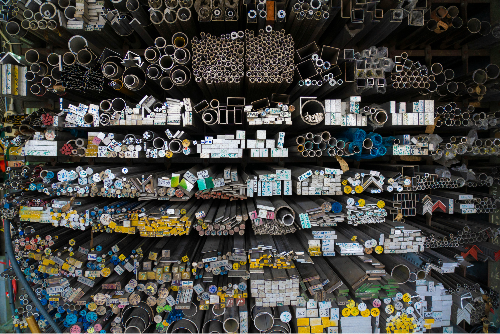What if a subcontractor or supplier in construction goes bankrupt?
- news and press

- Sep 16
- 4 min read
In the construction sector, multiple parties often work together: contractors, subcontractors, suppliers, and logistics service providers. This chain is complex, with many interdependencies. One weak link can have far-reaching consequences for a project. One of the biggest risks is the bankruptcy of a subcontractor or supplier.
Direct impact of bankruptcy
When a subcontractor or supplier goes bankrupt, projects can come to a halt or face significant delays. Materials may no longer be delivered, work remains unfinished, and financial uncertainty arises. The main contractor or client then needs to quickly decide how to keep the project running.
Key questions include:
Do the materials and goods that have already been paid for still belong to the client?
Can these items be collected and secured elsewhere?
What legal and logistical steps are needed to ensure continuity of the construction project?
Ownership after payment: legal foundation
In principle, goods only become the buyer’s property after delivery. Payment alone is usually not sufficient. Many suppliers apply a retention of title: they retain legal ownership until full payment has been made. This means that even if a partial payment has occurred, the goods legally still belong to the supplier.
To prevent materials from falling into the bankrupt estate, it's essential that contracts and invoices clearly state that ownership transfers after both payment and delivery. If this is correctly arranged, the client can claim the goods from the trustee.
A proactive strategy is to work with advance payments linked to immediate delivery and transport.
Once materials are paid for, they are immediately taken into physical possession by the buyer or a logistics partner. This allows one to prove that ownership transferred before the bankruptcy.
Immediate collection of materials
When it’s clear that materials have been paid for and are legally owned, they should be collected quickly. Time is critical: otherwise, the trustee may inventory the goods and include them in the bankrupt estate. Acting fast minimizes the risk of ownership disputes.
Practical steps include:
Checking invoices and contracts – confirm that payment has been made and ownership has transferred.
Contacting the trustee – report that certain materials are owned by the client and request their release.
Organizing transport – engage a logistics provider to collect the materials from the premises or warehouse of the bankrupt party.
Storage at a Bouwhub
A smart solution to reduce risk is using a Bouwhub. This is a logistics hub near the construction site where materials are temporarily stored and coordinated for delivery to the site.

The benefits:
Security: materials are immediately removed from the risk zone of the bankrupt supplier and kept under supervision.
Flexibility: materials can be delivered just-in-time to the construction site, minimizing on-site storage.
Cost savings: reduced failure costs and lower risk of theft or damage.
Overview: centralized storage offers better insight into what materials are already available.
A Bouwhub acts as a buffer between the uncertain situation with the bankrupt supplier and the continuity of the construction site.
Want a Bouwhub near you? Visit www.Bouwhub.net
Transport to the Bouwhub and construction site
After securing ownership, the logistical challenge begins. The transport process consists of three phases:
Collection from the (potentially) bankrupt party
Immediately after receiving permission from the trustee in case of bankruptcy.
As soon as possible to prevent the goods from becoming part of the estate.
Check completeness of the shipment.
Storage at the Bouwhub
Goods are registered and secured at a central location.
Planning and oversight are crucial to prevent materials from getting lost.
Just-in-time delivery to the construction site
Materials are only delivered when needed in the construction process.
This minimizes the risk of damage, theft, or delays on site.
Example scenario
Imagine a window frame supplier goes bankrupt. The main contractor has already paid for 80% of the frames, but only part of the order has been delivered. Because the contract states that ownership transfers upon payment and delivery, the contractor can claim the already paid and available frames.
By acting quickly and hiring a logistics partner, the frames are picked up from the bankrupt supplier’s warehouse and stored in a Bouwhub near the construction site. From there, they are delivered in phases, exactly when needed for installation.
This prevents construction from halting and avoids having to reorder frames from another supplier, which would cause costly delays.
Prevention is better than a cure
While it’s important to be prepared for emergencies, prevention is always better. Some measures construction companies can take:
Strong contracts: always include clauses stating that ownership transfers immediately after payment.
Supplier screening: regularly check the financial health of suppliers and subcontractors.
Escrow or deposit arrangements: payments via a third party who only releases funds upon delivery.
Standard use of Bouwhubs: offers logistical advantages even outside bankruptcy situations.
Backup suppliers: identify alternative suppliers for critical materials.
Conclusion
The bankruptcy of a subcontractor or supplier in construction carries major risks. By properly securing ownership rights, smartly linking payments to delivery, and immediately collecting and safeguarding materials in a Bouwhub, project continuity can be protected.
A Bouwhub is not just a practical logistics hub — it’s also a strategic tool to limit risks in case of bankruptcies. With good preparation, swift action, and a solid legal foundation, a construction project can continue even in turbulent times.
Learn more about Bouwhubs:www.Bouwhub.net or www.qonnected-logistics.com


_edited.png)
_edited.png)
_edited.png)


_edited.png)
_edited_edited.png)









_edited.png)



Comments